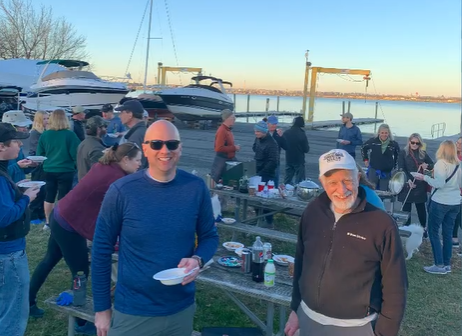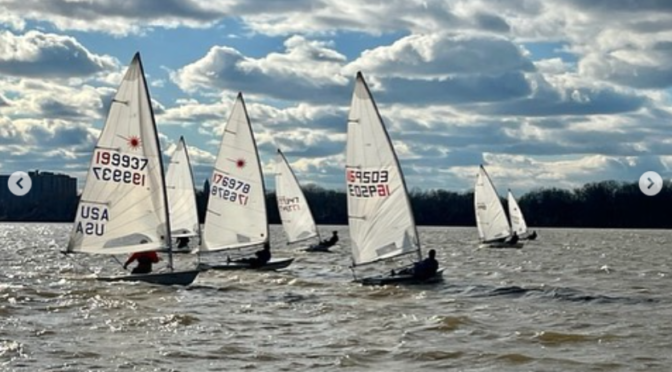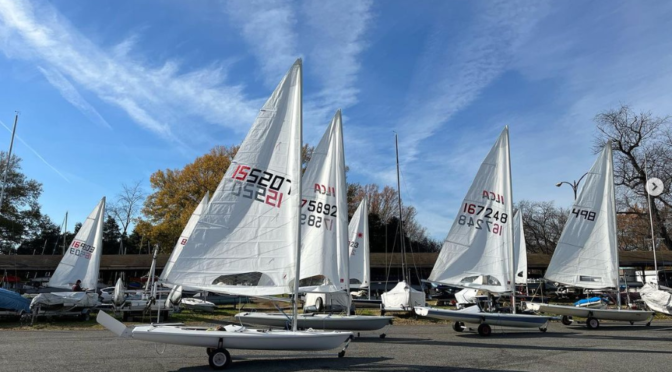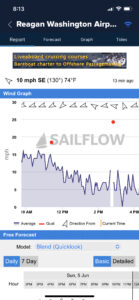Sunday was a refreshing day after such a chilly Christmas weekend The sun was shining, the temperatures were hovering on either side of 60 degrees, and the A-team was running races. The only problem was the wind never freshened beyond 4 or 5 mph.Nonetheless, we had four fun races.
Category Archives: Results
2022-2023 Laser Frostbite #6
I have the honor to be writing as your third place finisher, a result of nothing but fortitude. Seriously. So, here’s my take on the race. First, a thank you to Laura and Jim for setting a perfect course. It had a windward mark, a reaching mark and a downwind mark. Right distance and geometry. It started windy, out of the West, and continued to build, which favored those who stayed upright and made fewer mistakes. For example, I dropped multiple places by capsizing, hitting a starboard boat, undershooting the windward mark, and almost rear-ending Farley going close to 30 knots. I sailed the last race with Farley, netting both a second place and a DFL. Overall, great wind and weather and nice to be on the water, although we missed one of the great World Cup Finals of all time.
2022-2023 Laser Frostbite #4
After 3 weeks of no sailing for various weather states, we finally got a nice Sunday to sail. It was sunny with temps in the mid 40s. And the weather brought a great showing of sailors with 21 boats coming to sail.
Sadly the wind did not get the memo for the day. It was very challenging for both Race Committee and the racers. Nabeel and Kevin did an excellent job trying to keep up with the wind. We were able to get 5 races in. We had 2 races with shortened courses and 3 course adjustments. The wind was quite shifty with a lot of velocity changes. We had a few points where there was full hiking conditions and several where we were drifting. But all in all it was nice to be out on the water.
As far as sailing, I think we all need to ask Laura for the tips as she was the post consistent sailor out there. But I found that moving forward of the cockpit in the light wind and then moving back as it came back up I moved back to a normal position. With all the velocity shifts, I found that I was playing the cunningham more than usual to try and keep the sail looking full and not overly tight at the luff. Other than that it was mostly just the usual things, get a good start, find clear air on the downwinds, and stay patient in the lulls.
It was great to see the turnout and I look forward to seeing everyone out next weekend!
2022 Fall Series #1 (Sept 11)
It was a rainy morning, but the rain stopped in time for the sailors to rig and launch. Jim Graham ran three races down by the power plant because the water was high and made for a short trip back to the dock in case thunderstorms were threatening. Twelve sailors in four classes competed.
(Races 21-23 of the Spring & Fall Series)
2022 Spring Series Results
We had 20 races over 8 Sundays. Not all classes competed in all 20 races. To qualify, the boat must have sailed in 50 percent or more of the races in which at least one boat from the class competed. Boats that did not qualify have an # by their number.
These are preliminary pending corrections and interpretation of the NOR.
2022 Spring Series #8 (Jun 5)
Kyra Tallon ran the races with help from Jeff Witten.
It appears the winds were from the east and dying.
This is being posted late. Sorry.
Notes:
Laser 177053 competed but I don’t know who she is. That sail number is not registered or signed in.
2022 Spring Series #7 (May 22)
Dana Howe ran the races. Thank you!
This is being posted late. Sorry.
Races 15-17
Notes:
Sail number 806 is listed twice on the finish sheet for I-20s in race 3. I recorded the first finish.
Sail number 67 is listed on the finish sheet for Lightnings race 2, but I don’t have that boat registered.
2022 Spring Series #6
The weather looked like it was going to be a gray bummer but the wind came up to 8 mph and the sun came out. It ended up to be a beautiful day for sailing and we got 5 races in. We started with a 1lap race when the wind looked like it might not fill it, then switched to 2 laps once the wind and sun came out. Each fleet got another 1 lap race to end the day. There were 3 Albacores, 3 Buccaneers, 3 Lightnings, and 6 I-20s. Thanks again to Jess, Dana, and Eva for helping out on RC.
— Tom Hutton
PS: The protest was about using kinetics, i.e. rocking the boat to gain speed.
2022 Spring Series #3
It was a very very light wind day. Nevertheless, the cranes were working and the water temp was up to 60 degrees so 16 boats launched and with the help of the flooding tide slowly made their way up the river.
The winds were forecast to be light and from the NW and eventually clocking to the east and picking up. But they were not. Any puff of wind that was came from the WNW.
The RC decided to spare the sailors trying to get all the way to Haines Point where the winds were no better, and set up a course on the other side of the airport landing pier. That despite only four feet of depth but with the hope that as the tide continued to flood the depth would get better.
The first race was declared a W-2 but the RC decided to shorten at the leeward mark with the hope the wind was going to clock to the north. The RC reset for a more northerly wind but, alas, it came back to the WNW. So race 2 was a port tack start and a reach-reach course. Oh well. The RC was still hoping for that north wind to fill in for a third race, but it was not to be and the sailors were sent home around 2:30.
RC was Nabeel Alsalam, John Hart, and Henry Rood on the 19 and Michael Bors and Peter Pietra on the 17.
2022 Spring Series #2
It was a cloudy chilly day with air temps in the 50s. That, cranes that don’t work, a small craft advisory (winds in the teens with gusts up into the 20s), and a scary email about the dangers of falling into cold water (about 52F) kept sailors away.
Nevertheless, Stew Harris, Barney Harris and a team of I-20 sailors took the two skiff out and set up Olympic courses for the two Lightnings, one Albacore, and one Laser. We all started together. The Lightnings did not fly their spinnakers.
The wind was a combination of a westly off of the airport and a northerly. In race 2, Frank Gallagher in Lightning “Resistance Is Futile” couldn’t make the pin and so was very late starting but nonetheless got to the windward mark first because he worked those two winds well.
Barney followed us around and took video with commentary about our sail trim. That will be posted soon for your education and amusement.
Tyler Philips and Laura Windecker in Albacore “Free Ride” had a classic capsize to windward at the gybe mark in race 3 as they were bearing off for the gybe and were hit by a puff. I think they should have delayed their gybe until the boat was up to speed in the puff. But, hey, Monday morning quarterbacking is easy (and fun).
We are using the 3-minute sequences and with higher winds and flapping sails it is easy to miss the sound signals, So I used my watch as backup.
The results aren’t very interesting with only 1 Albacore and 1 Laser so I won’t post just yet.




